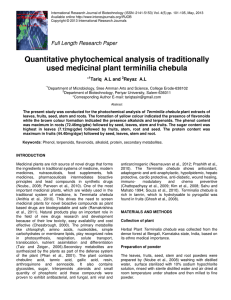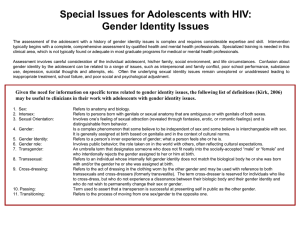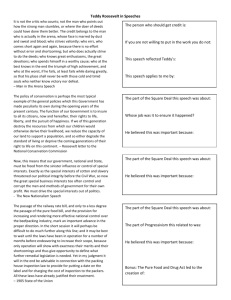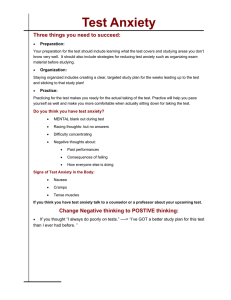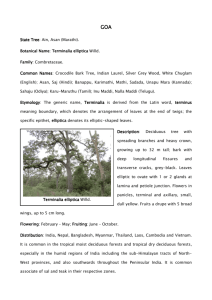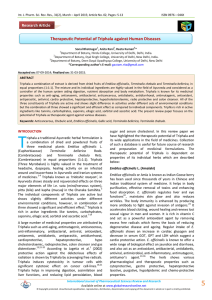Document 13308896
advertisement
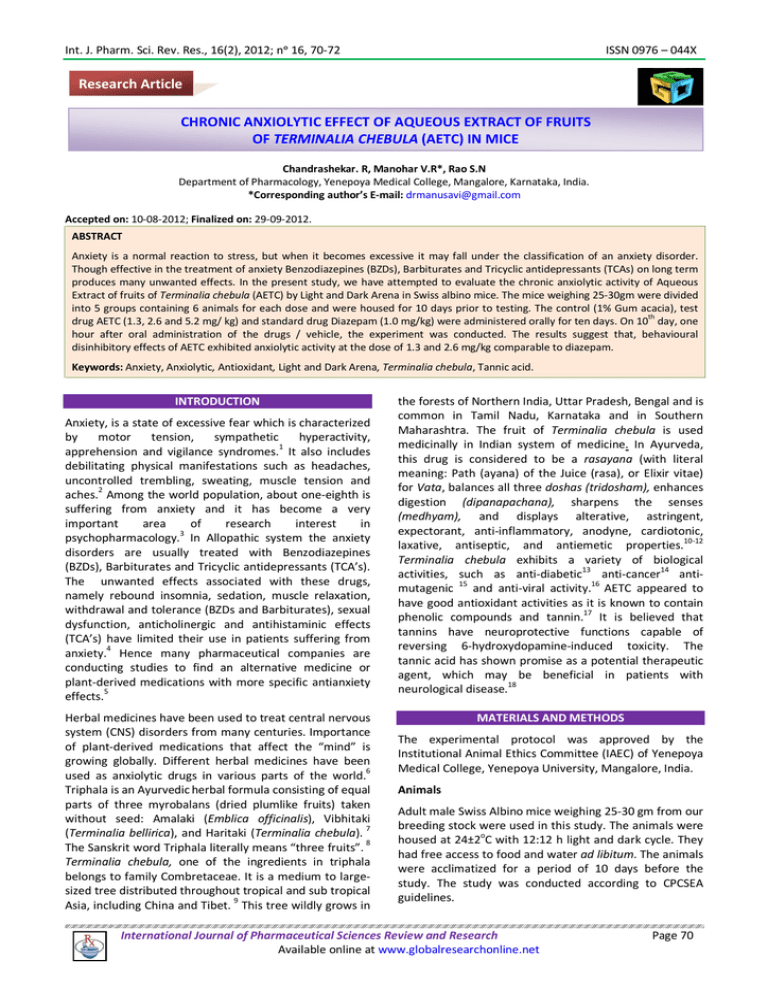
Int. J. Pharm. Sci. Rev. Res., 16(2), 2012; nᵒ 16, 70-72 ISSN 0976 – 044X Research Article CHRONIC ANXIOLYTIC EFFECT OF AQUEOUS EXTRACT OF FRUITS OF TERMINALIA CHEBULA (AETC) IN MICE Chandrashekar. R, Manohar V.R*, Rao S.N Department of Pharmacology, Yenepoya Medical College, Mangalore, Karnataka, India. *Corresponding author’s E-mail: drmanusavi@gmail.com Accepted on: 10-08-2012; Finalized on: 29-09-2012. ABSTRACT Anxiety is a normal reaction to stress, but when it becomes excessive it may fall under the classification of an anxiety disorder. Though effective in the treatment of anxiety Benzodiazepines (BZDs), Barbiturates and Tricyclic antidepressants (TCAs) on long term produces many unwanted effects. In the present study, we have attempted to evaluate the chronic anxiolytic activity of Aqueous Extract of fruits of Terminalia chebula (AETC) by Light and Dark Arena in Swiss albino mice. The mice weighing 25-30gm were divided into 5 groups containing 6 animals for each dose and were housed for 10 days prior to testing. The control (1% Gum acacia), test th drug AETC (1.3, 2.6 and 5.2 mg/ kg) and standard drug Diazepam (1.0 mg/kg) were administered orally for ten days. On 10 day, one hour after oral administration of the drugs / vehicle, the experiment was conducted. The results suggest that, behavioural disinhibitory effects of AETC exhibited anxiolytic activity at the dose of 1.3 and 2.6 mg/kg comparable to diazepam. Keywords: Anxiety, Anxiolytic, Antioxidant, Light and Dark Arena, Terminalia chebula, Tannic acid. INTRODUCTION Anxiety, is a state of excessive fear which is characterized by motor tension, sympathetic hyperactivity, apprehension and vigilance syndromes.1 It also includes debilitating physical manifestations such as headaches, uncontrolled trembling, sweating, muscle tension and aches.2 Among the world population, about one-eighth is suffering from anxiety and it has become a very important area of research interest in psychopharmacology.3 In Allopathic system the anxiety disorders are usually treated with Benzodiazepines (BZDs), Barbiturates and Tricyclic antidepressants (TCA’s). The unwanted effects associated with these drugs, namely rebound insomnia, sedation, muscle relaxation, withdrawal and tolerance (BZDs and Barbiturates), sexual dysfunction, anticholinergic and antihistaminic effects (TCA’s) have limited their use in patients suffering from 4 anxiety. Hence many pharmaceutical companies are conducting studies to find an alternative medicine or plant-derived medications with more specific antianxiety 5 effects. Herbal medicines have been used to treat central nervous system (CNS) disorders from many centuries. Importance of plant-derived medications that affect the “mind” is growing globally. Different herbal medicines have been used as anxiolytic drugs in various parts of the world.6 Triphala is an Ayurvedic herbal formula consisting of equal parts of three myrobalans (dried plumlike fruits) taken without seed: Amalaki (Emblica officinalis), Vibhitaki (Terminalia bellirica), and Haritaki (Terminalia chebula). 7 The Sanskrit word Triphala literally means “three fruits”. 8 Terminalia chebula, one of the ingredients in triphala belongs to family Combretaceae. It is a medium to largesized tree distributed throughout tropical and sub tropical Asia, including China and Tibet. 9 This tree wildly grows in the forests of Northern India, Uttar Pradesh, Bengal and is common in Tamil Nadu, Karnataka and in Southern Maharashtra. The fruit of Terminalia chebula is used medicinally in Indian system of medicine. In Ayurveda, this drug is considered to be a rasayana (with literal meaning: Path (ayana) of the Juice (rasa), or Elixir vitae) for Vata, balances all three doshas (tridosham), enhances digestion (dipanapachana), sharpens the senses (medhyam), and displays alterative, astringent, expectorant, anti-inflammatory, anodyne, cardiotonic, laxative, antiseptic, and antiemetic properties.10-12 Terminalia chebula exhibits a variety of biological activities, such as anti-diabetic13 anti-cancer14 antimutagenic 15 and anti-viral activity.16 AETC appeared to have good antioxidant activities as it is known to contain 17 phenolic compounds and tannin. It is believed that tannins have neuroprotective functions capable of reversing 6-hydroxydopamine-induced toxicity. The tannic acid has shown promise as a potential therapeutic agent, which may be beneficial in patients with 18 neurological disease. MATERIALS AND METHODS The experimental protocol was approved by the Institutional Animal Ethics Committee (IAEC) of Yenepoya Medical College, Yenepoya University, Mangalore, India. Animals Adult male Swiss Albino mice weighing 25-30 gm from our breeding stock were used in this study. The animals were housed at 24±2oC with 12:12 h light and dark cycle. They had free access to food and water ad libitum. The animals were acclimatized for a period of 10 days before the study. The study was conducted according to CPCSEA guidelines. International Journal of Pharmaceutical Sciences Review and Research Available online at www.globalresearchonline.net Page 70 Int. J. Pharm. Sci. Rev. Res., 16(2), 2012; nᵒ 16, 70-72 Sample Size, Grouping and Dose of the Drugs Animals were divided into 5 groups (Control, Standard & Test drug) containing 6 animals making a total number of 30 animals (Table 1). Table 1: Drugs / Dose of the Drugs, Groups and Number of Mice in Each Group Drugs / Dose Control (1% Gum acacia) (10 ml/kg) Diazepam (1.0 mg/kg) AETC (1.3 mg/kg) AETC (2.6 mg/kg) AETC (5.2mg/kg) Groups Number of Mice (n=6) I 6 II III I V 6 6 6 6 Drugs and chemicals The standard anxiolytic drug Diazepam was obtained from our institutional pharmacy. The test drug Terminalia chebula was provided by Al Thary Enterprises, Mangalore. 1% gum acacia (vehicle) from Dept of Pharmacology, Yenepoya Medical College, Yenepoya University, Mangalore. Apparatus: Light and dark arena The apparatus consisted of an open top wooden box. Two distinct chambers, a black chamber (20 X 30 X 35cm) ISSN 0976 – 044X painted black and illuminated with dim red light and a bright chamber (30 X 30 X 35 cm) painted white and brightly illuminated with 100W white light source, were located 17 cm above the box. The two chambers were connected through a small open doorway (7.5 X 5 cm) situated on the floor level at the centre of the partition. Behavioural assessment The animals were divided randomly into control and experimental groups (n=6). Group 1 received the vehicle, 1% gum acacia(10ml/kg) and served as the control group, groups 2, 3 and 4 received AETC in doses of 1.3, 2.6 & 5.2 mg/kg, and group 5 received the standard drug Diazepam th (1.0mg/kg) per orally for ten days. On 10 day behavioural evaluation was carried out 60 minutes post drug/vehicle administration. Anxiolytic activity of AETC was evaluated using the experimental model of Light and Dark arena (Table 2). Behavioural assessment was carried out by observing the time spent in bright arena, number of entries in to bright arena and number of rears in bright arena. Statistical analysis The data were analyzed by one-way ANOVA and Post-hoc comparisons were performed by applying Dunnet’s multiple comparison test. P <0.05 was considered statistically significant. Table 2: Effect of Chronic Administration of AETC on Behaviour by Light and Dark Arena in Mice Drugs/ Groups 1% Gum acacia 10.0ml/kg) Diazepam(1.0 mg/kg) AETC 1.3 mg/kg AETC 2.6 mg/kg AETC 5.2 mg/kg Time spent in bright arena (sec) 94.01±0.6 182.73±1.0 164.33±8.4*** 161.34±3.4*** 83.35±4.2* Number of entries in to bright arena 1.33±0.2 4.66±0.4 4±0.3*** 3.16±0.4*** 1.33±0.2* Number of rears in bright arena 2.66±0.3 5.83±0.3 4±0.2** 4.66±0.3*** 2±0.3* n=6. The observation are mean ± SEM *p>0.05, **p<0.05, ***p< 0.01 as compared control (ANOVA followed by Dennett’s multiple comparison test) AETC- Aqueous Extract of Terminalia chebula. RESULTS AND DISCUSSION Anxiety is a psychological and physiological state characterized by cognitive, somatic, emotional, and behavioural components. Benzodiazepines (BZDs) are the major class of compounds used in anxiety and they remain the most commonly prescribed treatment for anxiety. Hence the search for safe and effective alternate anxiolytic agent. Fruits of Terminalia chebula have many medicinal uses and AETC contains phenolic compounds and tannin. Tannins have neuroprotective function and antioxidant property. In the present study, we have attempted to evaluate the acute anxiolytic activity of Aqueous Extract of fruits of Terminalia chebula (AETC) by Light and Dark Arena in Swiss albino mice. Behavioural assessment was carried out by observing the time spent in light arena, number of entries in to light arena and number of rears in light arena. Our results (Table 2) suggest that, behavioural disinhibitory effects of AETC exhibited anxiolytic activity at the dose of 1.3 and 2.6 mg/kg comparable to diazepam by increase in time spent in bright arena (p<0.01). In the dose of 1.3 mg /kg (p<0.05) and 2.6 mg /kg (p<0.01) shows the increase in number of entries in to the bright arena. Number of rears were also increased in the dose of 1.3 and 2.6 mg/kg (p<0.01) in the bright arena. CONCLUSION The results suggest that, behavioural disinhibitory effects of AETC exhibited anxiolytic activity at the dose of 1.3 and 2.6 mg/kg comparable to diazepam. However, further studies are needed to evaluate its mechanism of action and therapeutic benefit as an adjuvant in the treatment of anxiety disorders. International Journal of Pharmaceutical Sciences Review and Research Available online at www.globalresearchonline.net Page 71 Int. J. Pharm. Sci. Rev. Res., 16(2), 2012; nᵒ 16, 70-72 REFERENCES 1. Poonam Mahendra, Shradha Bisht. Anti-anxiety activity of Coriandrum sativum assessed using different experimental anxiety models. Indian J Pharmacol, 43(5): 2011, 574–577. ISSN 0976 – 044X 11. Ahmad I, Mehmood Z, Mohammad F. Screening of some Indian medicinal plants for their antimicrobial properties. J Ethnopharmacol, 62(2):1998, 183-93. 2. Shaheen E Lakhan, Karen F Vieira. Nutritional and herbal supplements for anxiety and anxiety-related disorders: systematic review. Nutrition Journal 9:2010, 42. 12. Sato Y, Oketani H, Singyouchi K, Ohtsubo T, Kihara M, Shibata H, Higuti T. Extraction and purification of effective antimicrobial constituents of Terminalia chebula RETS. against methicillin-resistant Staphylococcus aureus. Biol Pharm Bull, 20(4):1997, 401-404. 3. Kulkarni SK, Singh K, Bishnoi M, Comparative behavioral profile of newer antianxiety drugs on different mazes. Indian Journal of Expt. Biol, 46:2008, 633-638. 13. Sabu MC, Kuttan R: Anti-diabetic activity of medicinal plants and its relationship with their antioxidant property. J. Ethanopharmacol, 81:2002, 155–160. 4. Lader M, Morton S. Benzodiazepine problems. Br J Addict, 83:1991, 823–8. 5. Rabbani M, Sajjadi SE and Mohammadi A, Evaluation of the anxiolytic effect of Nepeta persica Boiss. in mice. eCAM, 5 (2):2008, 181– 186. 14. Saleem A, Husheem M, Harkonen P, Pihalaja K: Inhibition of cancer cell growth by crude extract and the phenolics of Terminalia chebula Retz. fruit. J. Ethnopharmacol, 81:2002, 327–336. 6. Poonam Mahendra , Shradha Bisht. Anti-anxiety activity of Coriandrum sativum assessed using different experimental anxiety models. Indian J Pharmacol, 43(5):2011, 574–577. 7. Anne McIntyre (7 September 2005). Herbal treatment of children: Western and Ayurvedic perspectives. Elsevier Health Sciences. pp. 278. 8. Ayurvedic pharmacopoeia committee. The Ayurvedic Formulary of India, Part I, 2nd English ed. New Delhi: Controller of Publications; 2003. 9. Varrier, PS. Indian Medicinal Plants: A Compendium of 500 species. Edited by PK Warrier, VPK Nambiar and C Ramankutty. Vol. 5. Hyderabad: Orient Longman. 1996. p.263. 10. Jagtap AG, Karkera SG. Potential of the aqueous extract of Terminalia chebula as an anticaries agent. J Ethnopharmacol, 68(1-3):1999, 299-306. 15. Kaur S, Arora S, Kaur K, Kumar S: The in vitro antimutagenic activity of Triphala – an Indian herbal drug. Food Chem. Toxicol, 40:2002, 527–534. 16. Ahn MJ, Kim CY, Lee JS, Kim TG, Kim SH, Lee CK, Lee BB, Shin GG, Huh H, Kim J: Inhibition of HIV-I integrase by galloyl glucose from Terminalia chebula and flavonol glycoside gallates from Euphorbia pekinensis. Planta Med, 68:2002, 457–459. 17. Chia Lin Chang, Che San Lin. Phytochemical Composition, Antioxidant Activity, and Neuroprotective Effect of Terminalia chebula Retzius Extracts. Evidence-Based Complementary and Alternative Medicine, 2012:2012, 1-7. 18. Nobre-Junior, Helio V. et al. "Neuroprotective Actions of Tannins from Myracrodruon urundeuva on 6Hydroxydopamine-Induced Neuronal Cell Death". Journal of Herbs, Spices & Medicinal Plants (Haworth Press) 13 (2), 2007. *********************** International Journal of Pharmaceutical Sciences Review and Research Available online at www.globalresearchonline.net Page 72


